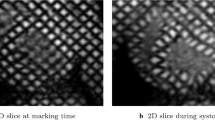Abstract
We present an automatic workflow to extract myocardial constitutive parameters from clinical data. Our framework assimilates cine and 3D tagged Magnetic Resonance Images (MRI) together with left ventricular (LV) cavity pressure recordings to characterize the mechanics of the LV. Dynamic C 1-continuous meshes are automatically fitted using both the cine MRI and 4D displacement fields extracted from the tagged MRI. The passive filling of the LV is simulated, with patient-specific geometry, kinematic boundary and loading conditions. The mechanical parameters are identified by matching the simulated diastolic deformation to observed end-diastolic displacements. We applied our framework to two heart failure patient cases and one normal case. The results indicate that while an end-diastolic measurement does not constrain the mechanical parameters uniquely, it does provide a potentially robust indicator of myocardial stiffness.
Access this chapter
Tax calculation will be finalised at checkout
Purchases are for personal use only
Preview
Unable to display preview. Download preview PDF.
Similar content being viewed by others
References
Abraham, T., Lardo, A., Kass, D.: Myocardial Dyssynchrony and Resynchronization. Heart Failure Clinics 2(2), 179–192 (2006)
Augenstein, K., Cowan, B., LeGrice, I., Nielsen, P., Young, A.: Method and apparatus for soft tissue material parameter estimation using tissue tagged Magnetic Resonance Imaging. Journal of Biomechanical Engineering 127, 148 (2005)
Chandrashekara, R., Mohiaddin, R., Rueckert, D.: Analysis of 3-D myocardial motion in tagged MR images using nonrigid image registration. IEEE Transactions on Medical Imaging 23(10), 1245–1250 (2004)
Guccione, J., McCulloch, A., Waldman, L.: Passive material properties of intact ventricular myocardium determined from a cylindrical model. Journal of Biomechanical Engineering 113, 42–55 (1991)
Lamata, P., Niederer, S., Barber, D., Norsletten, D., Lee, J., Hose, R., Smith, N.: Personalization of cubic hermite meshes for efficient biomechanical simulations. In: Jiang, T., Navab, N., Pluim, J.P.W., Viergever, M.A. (eds.) MICCAI 2010. LNCS, vol. 6362, pp. 380–387. Springer, Heidelberg (2010)
Land, S., Niederer, S., Smith, N.: Efficient computational methods for strongly coupled cardiac electromechanics. In: IEEE Transactions on Bio-medical Engineering (2011) (in press)
Niederer, S., Plank, G., Chinchapatnam, P., Ginks, M., Lamata, P., Rhode, K., Rinaldi, C., Razavi, R., Smith, N.: Length-dependent tension in the failing heart and the efficacy of cardiac resynchronization therapy. Cardiovascular Research (2010)
Nordsletten, D., Kay, D., Smith, N.: A non-conforming monolithic finite element method for problems of coupled mechanics. Journal of Computational Physics (2010)
Omens, J., MacKenna, D., McCulloch, A.: Measurement of strain and analysis of stress in resting rat left ventricular myocardium. Journal of Biomechanics 26(6), 665–676 (1993)
Rueckert, D., Sonoda, L., Hayes, C., Hill, D., Leach, M., Hawkes, D.: Nonrigid registration using free-form deformations: application to breast MR images. IEEE Transactions on Medical Imaging 18(8), 712–721 (1999)
Sermesant, M., Moireau, P., Camara, O., Sainte-Marie, J., Andriantsimiavona, R., Cimrman, R., Hill, D.L.G., Chapelle, D., Razavi, R.S.: Cardiac function estimation from MRI using a heart model and data assimilation: Advances and difficulties. In: Frangi, A.F., Radeva, P., Santos, A., Hernandez, M. (eds.) FIMH 2005. LNCS, vol. 3504, pp. 325–337. Springer, Heidelberg (2005)
Smith, N., Nickerson, D., Crampin, E., Hunter, P.: Multiscale computational modelling of the heart. Acta Numerica, 371–431 (2004)
Usyk, T., Mazhari, R., McCulloch, A.: Effect of laminar orthotropic myofiber architecture on regional stress and strain in the canine left ventricle. Journal of Elasticity 61(1), 143–164 (2000)
Wang, J., Nagueh, S.: Current perspectives on cardiac function in patients with diastolic heart failure. Circulation 119(8), 1146 (2009)
Wang, L., Wong, K., Zhang, H., Liu, H., Shi, P.: A Statistical Physiological-Model-Constrained Framework for Computational Imaging of Subject-Specific Volumetric Cardiac Electrophysiology Using Optical Imaging and MRI Data. Statistical Atlases and Computational Models of the Heart, 261–269 (2010a)
Wang, V., Lam, H., Ennis, D., Cowan, B., Young, A., Nash, M.: Modelling passive diastolic mechanics with quantitative MRI of cardiac structure and function. Medical Image Analysis 13(5), 773–784 (2009)
Wang, V., Lam, H., Ennis, D., Cowan, B., Young, A., Nash, M.: Cardiac Active Contraction Parameters Estimated from Magnetic Resonance Imaging. Statistical Atlases and Computational Models of the Heart, 194–203 (2010b)
Author information
Authors and Affiliations
Editor information
Editors and Affiliations
Rights and permissions
Copyright information
© 2011 Springer-Verlag Berlin Heidelberg
About this paper
Cite this paper
Xi, J. et al. (2011). An Automatic Data Assimilation Framework for Patient-Specific Myocardial Mechanical Parameter Estimation. In: Metaxas, D.N., Axel, L. (eds) Functional Imaging and Modeling of the Heart. FIMH 2011. Lecture Notes in Computer Science, vol 6666. Springer, Berlin, Heidelberg. https://doi.org/10.1007/978-3-642-21028-0_50
Download citation
DOI: https://doi.org/10.1007/978-3-642-21028-0_50
Publisher Name: Springer, Berlin, Heidelberg
Print ISBN: 978-3-642-21027-3
Online ISBN: 978-3-642-21028-0
eBook Packages: Computer ScienceComputer Science (R0)




